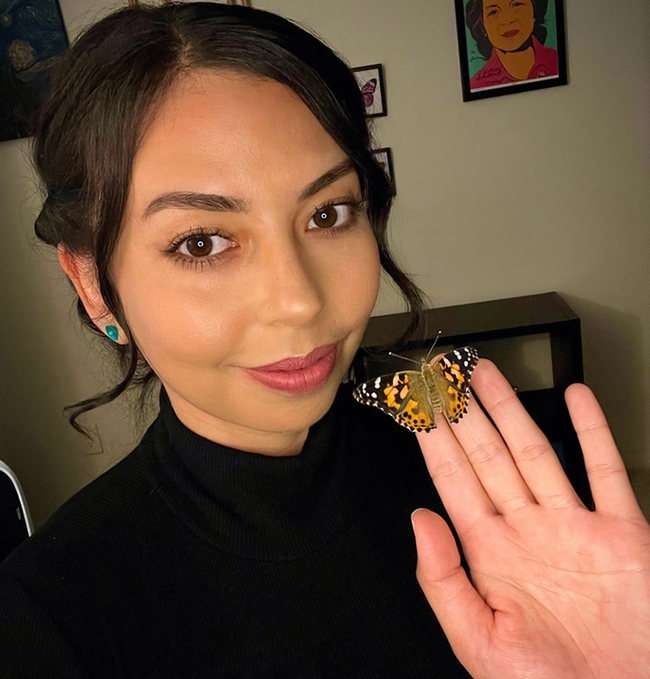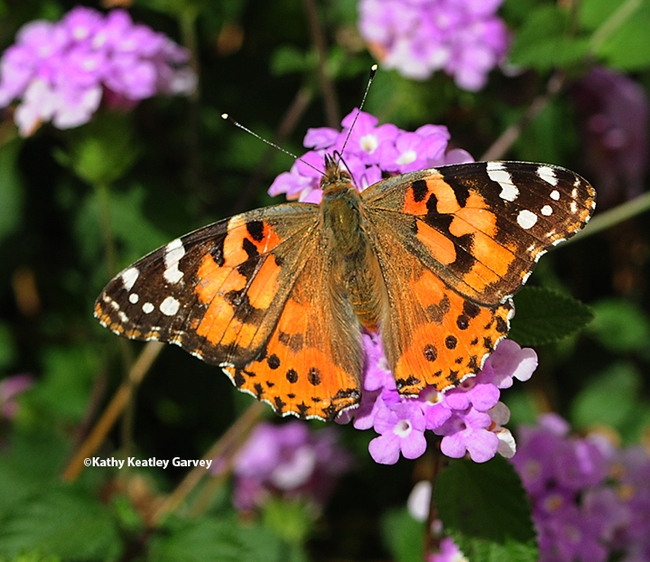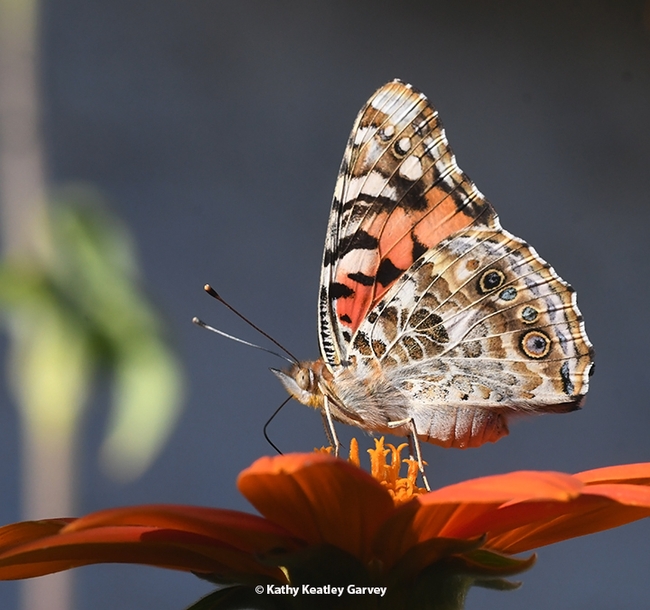
But painted ladies, Vanessa cardui, are also migratory.
As butterfly guru Art Shapiro, UC Davis distinguished professor emeritus, says on his website, Art Shapiro's Butterfly Site:
"This mass-migrant occurs in much of the Northern Hemisphere. Apparently the entire North American population winters near the US-Mexico border, breeding in the desert after the winter rains generate a crop of annual Malvaceous, Boraginaceous and Asteraceous hosts. The resulting butterflies migrate north. In good years (lots of desert rain) they may do so by billions, interfering with traffic and attracting the attention of the media. 2005 was one of the biggest Painted Lady years in history--perhaps the biggest, but how can we know? At Sacramento at the height of the migration butterflies were passing in one's field of vision at the rate of about 3 per second! 2006, by contrast, was a La Nina year with very little rain in the desert. The butterflies apparently gave up trying to breed there and flew north in February."
Shapiro, who has monitored the butterfly populations of Central California since 1972, points out that "The painted lady moves northward in a generational wave as the season progresses. Frequently it disappears altogether from the lowlands in summer. Beginning in August the movement reverses and butterflies head south toward the desert wintering grounds. The southward migration is a more protracted affair, with plenty of adult feeding and some breeding en route. Numbers tend to be highest east of the crest, on Rabbitbrush blossoms in October."
Enter Jolene Saldivar, a UC Davis Chancellor's Postdoctoral Fellow in the lab of Professor Louie Yang, who also studies painted ladies.
She will speak on "Disturbance in Coastal Sage Scrub and the Implications for Migratory Butterflies" at the next UC Davis Department of Entomology and Nematology seminar, set for 4:10 p.m., Monday, Oct. 28 in 122 Briggs Hall. Her seminar also will be on Zoom. The Zoom link: https://ucdavis.zoom.us/j/95882849672. The recorded seminar will be archived at
https://entomology.ucdavis.edu/seminars.
Saldivar completed her doctorate in plant biology at UC Riverside in June and then joined UC Davis as a Chancellor's Postdoctoral Fellow in the Yang lab. She is the recipient of a National Science Foundation Postdoctoral Research Fellowship in Biology.
"Jolene is interested in documenting plant-butterfly interaction networks across a management gradient, using isotopes to learn about the migratory ecology of painted lady butterflies, and developing species distribution models for butterflies and their host plants," relates Yang on his website.
Saldivar's abstract: "Disturbance plays a role in both maintaining and disrupting biodiversity and ecosystem productivity. With human activities drastically altering natural disturbance regimes for many ecosystems, understanding the factors that most impact recovery is vital for restoration and conservation efforts. California coastal sage scrub (CSS) is a fire-prone system with many endemic plant species, including fire-following forbs and shrubs. However, increased fire and plant invasions have impacted native recovery, which may have implications for plant-pollinator interactions."
"For my doctoral research, I investigated how a wildfire influenced CSS plant composition at four- to six years post-fire," Saldivar continues in her abstract. "I also assessed host plant suitability of CSS plant species by quantifying larval development and survival for commercially sourced painted lady butterflies (Vanessa cardui). Lastly, I leveraged community science observations of V. cardui throughout California shrub/scrub ecosystems during and outside of irruptive migrations. My dissertation proved valuable insights into the complex interactions between disturbance, plant communities and butterfly ecology in CSS, a largely threatened and degraded ecosystem. These findings have inspired my postdoctoral research which includes further investigation of post-disturbance recovery to help predict outcomes of climate-change and altered disturbance regimes across trophic levels."
Saldivar writes on her website: "My research interests include plant–pollinator interactions and disturbance. Specifically, I am interested in how invasive plant species and fire impact migratory pollinators and native annual forbs in coastal sage scrub habitats. For my research, I employ techniques in field work, lab work, and statistical analysis."
"As a first-generation college graduate and granddaughter of migrant farm workers, I am passionate about the recruitment and retainment of members of groups historically underrepresented in STEM. Through my mentorship and community engagement, I communicate my research, teach various technical skills, and provide resources to those seeking opportunities in higher education. I aim to show others that science is for everyone!"
Saldivar is a veteran of the U.S. Air Force, serving from 2008 to 2014. Her overseas assignments included Stuttgart, Germany; Bagram Air Base, Afghanistan; Al Udeid Air Base, Qatar; and various countries throughout Africa. (See more)
Among her publications: "Community Science Reveals High Diversity of Nectaring Plants Visited by Painted Lady Butterflies (Lepidoptera: Nymphalidae) in California Sage Scrub," published Sept. 30, 2022 in Environmental Entomology.
Nematologist Amanda Hodson, assistant professor, is coordinating the ENT seminars. The full list is here. For more information or for technical issues, contact Hodson at akhodson@ucdavis.edu.
Attached Images:

The painted lady, Vanessa cardui, is a migratory butterfly. This image, taken in Vacaville, shows the butterfly nectaring on Lantana. (Photo by Kathy Keatley Garvey)

A side view of a painted lady, Vanessa cardui, nectaring on a Mexican sunflower, Tithonia rotundifola. (Photo by Kathy Keatley Garvey)